Remote hand switch with 5m cable for external triggering of start or audio recording (if applicable) on Nor145.
The Nor140 is an advanced Class I sound level meter and analyzer with octave and 1/3 octave band analysis, and parallel A, C and Z weighting networks.

The Nor140 is an advanced Class I sound level meter and analyzer with octave and 1/3 octave band analysis, and parallel A, C and Z weighting networks.
The Nor140 is a Class I Sound Level Meter designed for a wide range of tasks ranging from basic noise measurements to advanced noise analysis, including room and building acoustics applications. It also supports vibration measurements when paired with an IEPE vibration sensor.
The included data transfer software with every unit enables users to download, view, and generate Excel reports of the measurements, or perform further analysis using Norsonic’s software suite of postprocessing and reporting tools for building acoustics, environmental noise, and sound power.
Overall Performance
The Nor140 fulfil the following standards set for sound level meters, 1/1-octave and 1/3 octave filters: IEC 61672-1:2002 class 1, IEC 60651 class 1, IEC 60804 class 1, IEC 61260 class 1, ANSI S1.4-1983 (R2001) with amendment S1.4A-1985 class 1, ANSI S1.43-1997 (R2002) class 1, ANSI S1.11-2004 class 1.
Number of channels: 1
Input connector: 7 pin LEMO connector for Norsonic microphone systems.
Microphone: Nor1225, 1/2”, freefield, 50 mV/Pa.
Preamplifier: Nor1209 (Normal) or IEPE-type by menu selection.
Preamplifier supply voltage: ±15 volt, max 3 mA
Polarisation voltage: 0 V and 200 V, selectable.
Maximum input signal: ±11V peak
Preamplifier IEPE®:
Supply current: 4mA
Supply voltage: 24V
Input impedance: >100 kΩ, <650 pF
The input section is equipped with an analogue highpass filter to reduce noise from wind or other sources with frequencies below the frequency range for measurements. The filter is switched on if the limited frequency range is selected (>6,3 Hz).
Filter type: 3rd order HP filter (-3 dB at 3,4 Hz, Butterworth response).
The analogue input signal is converted to a digital signal by a multirange sigma-delta converter with an effective sampling frequency of 48 kHz. The anti-aliasing filter is a combination of an analogue and a digital filter.
Simultaneous measurement of A and C-weighting or A- and Z-weighting. 1/1 octave band or 1/3 octave band levels may be measured simultaneously if options providing these weightings are installed.
1/1 octave filters: 0,5 – 16000 Hz, class 1, digital IIR filters, base 10 system (IEC 61260) and ANSI S1.11- 2004 Class 1.
1/3 octave filters: 0,4 – 20000 Hz, class 1, digital IIR filters, base 10 system (IEC 61260) and ANSI S1.11- 2004 Class 1.
Detector type: Digital true rootmean-square (RMS) detection, resolution 0.1 dB which may optionally be increased to 0.01 dB for indicated levels in the range –9.99 to 99.99 dB.
Crest factor capability: The crest factor is only limited by the peak-value of the signal.
Simultaneous measurement of the following functions: SPL, Lmax; Lmin; Leq; LE; Lpeak; LN; LeqI; LEI; LTMax5
The self-noise is measured with the calibration set to –26.0 dB corresponding to a microphone sensitivity of 50mV/Pa. For voltage input, the level 0 dB then corresponds to 1µV. Typical values for the self-noise are 5 dB lower than the values stated. Noise measured with 18 pF microphone dummy and microphone preamplifier Nor1209, averaged over 30 s of measurement time:
A-weighted: 13 dB
C-weighted: 15 dB
Z-weighted: 25 dB
1/3 oct: 6.3 Hz to 250 Hz: 10 dB
1/3 oct: 315 Hz to 20 kHz: 5 dB
Noise measured with Nor1225 microphone and preamplifier Nor1209, averaged over 30 s of measurement time:
A-weighted: 18 dB
C-weighted: 22 dB
Z-weighted: 30 dB
1/3 oct: 6.3 Hz to 250 Hz: 15 dB
1/3 oct: 315 Hz to 20 kHz: 10 dB
Batteries: 4 cells, IEC LR6, AA-sized
Typical battery life time: up to 14 hours
External DC: 11 – 16V. Power consumption approximately 1.2W depending on selected modes of operation. The mains adapter Nor340 is recommended for use with the instrument. If the external supply falls below 9V, the instrument will use the internal batteries if available. If the instrument switched itself off due to loss of power, it will automatically switch on and resume normal operation after reapplying the external DC supply.
The display is a monochrome, transreflective LCD graphical display with 160×240 pixels (W×H) with automatic temperature compensation for contrast and viewing angle. Pressing the light key illuminates the display. The light switches off automatically
two minutes after the last operation of any key. The bargraph display covers 80dB which may be scrolled in 10dB steps to cover the total range.
The instrument may use SD memory card for storing of setup information, sound recordings and measurement results. SD memory card included in the delivery
Measured data is stored in the internal memory of the sound level meter or on the SD memory card. The internal memory is of the “flash” type retaining the information without battery supply. Approximately 25 Mbyte is available for the data storage
Temperature: –10°C to +50°C
Humidity: 5% to 90% RH, dewpoint less than 40°C.
Atmospheric pressure: 85 kPa to 108 kPa.
Temperature: –30°C to +60°C
Humidity: 5% to 90% RH, dewpoint less than 40°C.
Atmospheric pressure: 50 kPa to 108 kPa.
Depth: 30 mm
Width: 75 mm
Weight incl. batteries: 410 g
Length, excl.microphone/preamplifier: 210 mm
Length, incl. microphone/preamplifier: 292 mm
The Nor140 can be enhanced with a wide range of optional features, giving users the flexibility to customize the instrument to meet their specific needs. These features can be ordered and activated at any time by simply adding a new set of activation codes.
Nor140 ENV
Nor140 as Advanced Level package (e.g. for ENV), containing options: 01, 03, 04, 05, 06, 07, 08, 14, 16.
Nor140 BA
Nor140 as Advanced Building Acoustics package with on board rating, containing options: 01, 03, 06, 07, 09, 10, 11, 12.
Nor140 Cons
Option package containing options: 01, 02, 03, 04, 05, 06, 07, 08, 09, 10, 11, 12, 13, 14, 15, 16, 18.
When fitted with option 1, the Nor140 can perform real time frequency analysis in octaves covering the frequency bands 0.5 Hz to 16 kHz in one range. A limited frequency range 8 Hz – 16 kHz can be set in order to avoid low frequency noise. A 3 Hz 3rd order high pass filter is then enabled in the analogue input stage to prevent overload due to low frequency noise. The wide frequency range with full dynamic range of more than 120 dB makes the instrument well suited for both vibration and noise measurements.
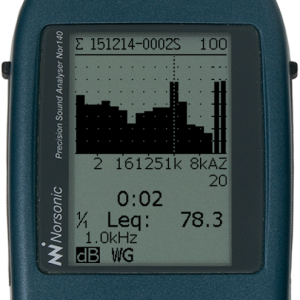
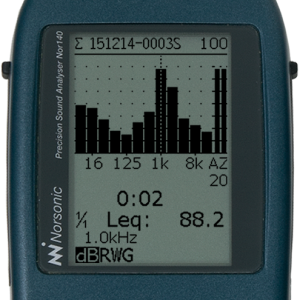
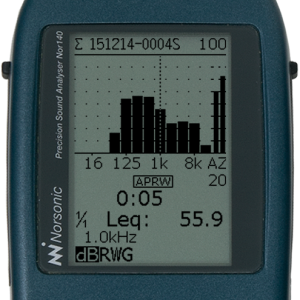
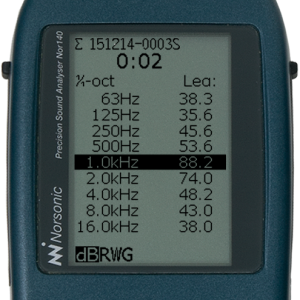
The reference spectra feature is used for comparison of any measured frequency spectrum with a pre-selected user defined spectrum. It functions for 1/1-octave, 1/3 octave and the spectral weighting networks. The measured spectrum may be compared to an upper limit, a lower limit or both. If the measured signal exceeds the boundaries, a “NoGo” warning is given on the screen,and a digital signal is set on the I/O port. This is useful for many applications such as product control and spectrum comparison.
Option 2 requires that minimum option 1 be installed!
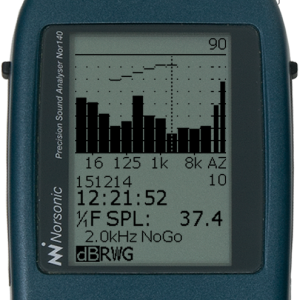
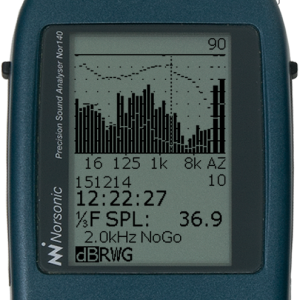
When fitted with option 3, the Nor140 can perform real time frequency analysis in 1/3 octave covering the frequency bands 0.4 Hz to 20 kHz in one range. A limited frequency range covering 6.3 Hz – 20 kHz can be set to avoid low frequency noise. A 3 Hz 3rd order high pass filter is then enabled in the analogue input stage to prevent overload due to low frequency noise.
The wide frequency range with full dynamic range of more than 120 dB makes the instrument well suited for both vibration and noise measurements.
Option 3 requires that minimum option 1 be installed.
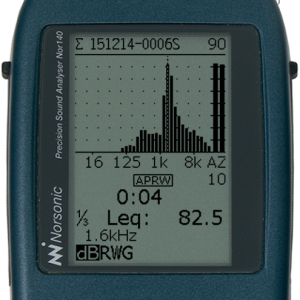
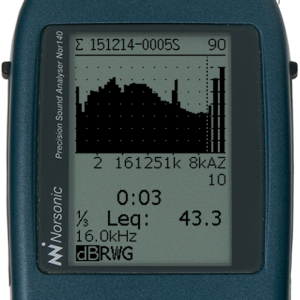
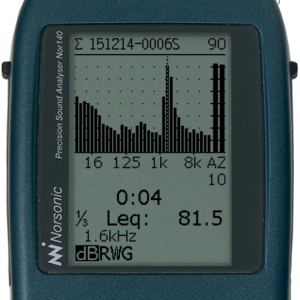
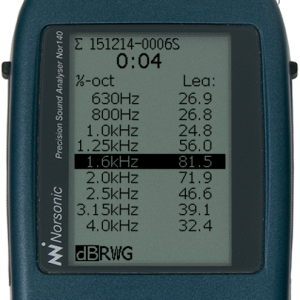
Option 4 adds statistical distribution to the Nor140 functionality. There are eight percentiles shown, out of which one is user selectable. The class width is 0.2 dB over the entire 130 dB range.
The statistical distribution calculations employs the F time constant and applies to the spectral weighting networks (A and C or Z) as well as all the individual 1/1 and 1/3-octave filter bands (if applicable). The back-erase feature, which deletes up to the ten most recent seconds of acquired global data prior to a pause upon resuming, updates the statistics buffers as well to maintain consistency.
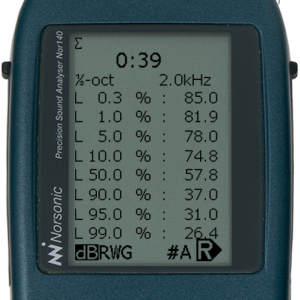
Option 5 enables parallel measurement of all time constants simultaneously. If real time filters are installed, the parallel time weighting functions are available for the individual filter bands as well.
Automatic markers:
A pause marker is inserted into the time profile in pause mode. A recorder marker is inserted when the instrument is doing a sound recording, and an overload marker is inserted if overload occurs.
The enhanced time profile mode allows logging of Leq, Lmax, Lmin, Lpeak, Le and SPL for all weighting networks and frequency bands for time constant F, S and I in parallel if option 5 parallel time constant is enabled. The user may select from one to all available parameters to log. The time resolution is from 25 ms logging to memory. If the frequency analysis option is installed, these values may be measured too, both as time profile multi spectrum values and as global values.
User controlled source coding
With option 7, the instrument gets eight marker functions, where as four are user defined. Three of these are single markers and one is a toggle marker.
Option 7 requires that minimum option 6 be installed.
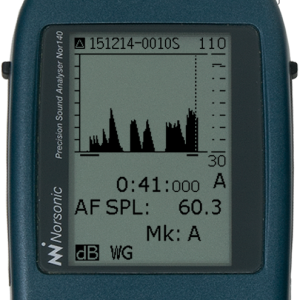
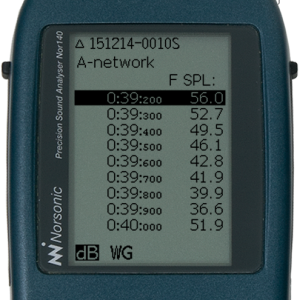
Option 8 allows storing the sound signal itself onto the SD card or the internal memory of Nor140 sound analyser. This option is especially useful for source identification. The sound recording can be trigged by an external hand switch, by a level trigger (requires option 16) or by a manual key push.
Several recording formats are supported, ranging from 8, 16 or 24 bit and with sampling rates of 12 or 48 kHz. Using 48 kHz sampling and the stored sound signal may be used for further processing. The Nor140 has a large dynamic range – exceeding 120 dB. This means that if you try to play back the signal on your PC you will – in most cases – hear nothing!
To overcome this problem a special digital gain, 0 – 96 dB, can be added to the sound recorded signal without affecting the calibration or measured values.
Another useful feature is that you may play a 10 sec reference tone – sine wave, pink or white noise in the beginning of a measurement to set a reference level when later replaying recorded data.
Option 8 requires that minimum option 6 be installed.
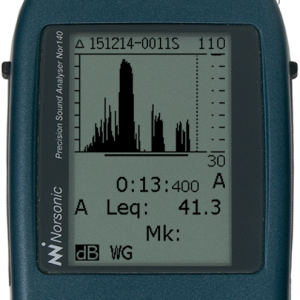
Option 9 requires that minimum option 1 be installed.
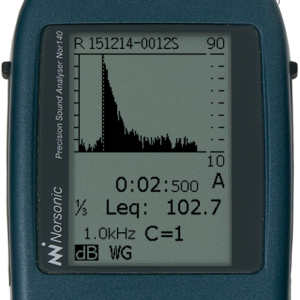
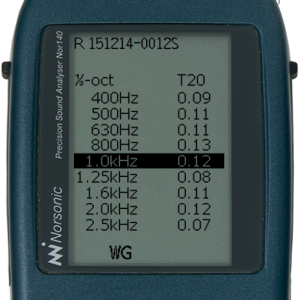
The signal generator option generates both white and pink noise. Both impulse excitation and continuous noise excitation are supported, making the noise generator useful for both reverberation time measurements as well as sound insulation measurements.
Option 11 turns your Nor140 into a powerful single channel building acoustic analyser. All the required parameters for performing both airborne and impact sound insulation are calculated. Using the Nor140 for measuring building acoustic, both airborne and impact noise has never been easier. With the Nor1028 NorBuild sound insulation reporting program, Norsonic offers a powerful and user-friendly building acoustic solution.
Option 11 requires that minimum option 1, 3, 9 and 10 be installed.
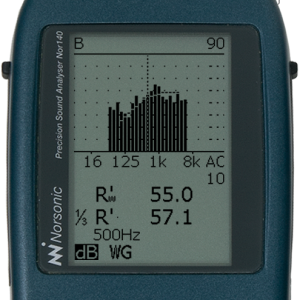
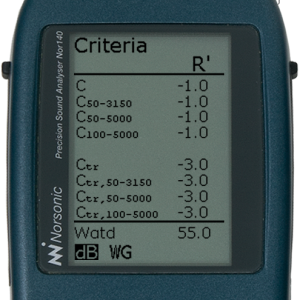
Used in combination with the CtrlBuild remote control feature of the NorBuild software type 1028, the Nor140 may perform advanced sound insulation measurement using the innovative Swept-Sine technique.
Adding STIPA option to Nor140 turns the analyser into a powerful tool for analysing the Speech Transmission quality in public areas. The method can be used to compare the speech trans-mission quality at various positions and under various conditions within the same listening space. STIPA replaces the former used RASTI method as a more accurate method compared to RASTI.
A measurement in one listening position takes about 13 sec. Unlike many other STIPA measurement systems, the Nor140 can also correct the results for the background noise. In addition all calculated indexes are displayed, not only the single STIPA value. This feature is valuable for engineers optimising the room acoustics in public spaces or other areas where the speech quality is important.
Option 13 requires that minimum option 1 be installed!
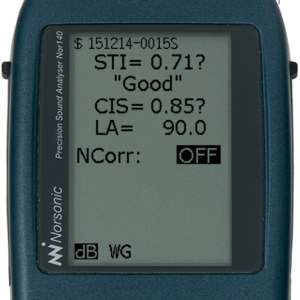
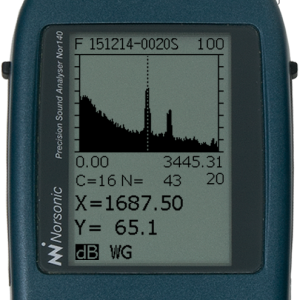
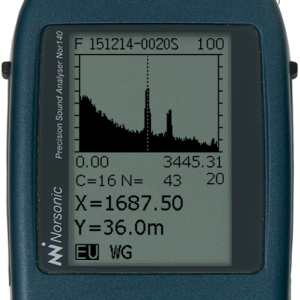
This option allows the user to perform survey grade LWA sound power level measurements in the field without any other external device. A perfect tool for verifying the sound power level of equipment after installation. A graphical wizard guides the user through the measurement – easy and intuitive to use!

A special pre-trigger feature on the audio recording can be set up to capture the latest seconds of the audio signal prior to the trigger point.
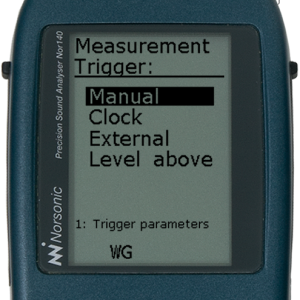
Option 17 requires that minimum option 1 and 3 are installed
Audiometer calibration
Audiometry is the testing of hearing ability. Audiometric tests determine a subject’s hearing levels with the help of an audiometer. For reliable test results, it is essential that audiometers are regularly calibrated in accordance with the relevant standards.
Nor140 can be equipped with the option for audiometer calibration which provides the ability for acoustical measurement of frequency and level of the test signal as well as harmonic distortion. Measurement take only 2 seconds and is performed in an intuitive way presenting the 1/3 octave band spectrum together with a result table containing values for frequency of the test tone, level of the test tone, Z Leq and harmonic distortion.
The Nor140 is widely used as frontend in applications developed by system integrators. A typical example is TopSonic, a world leading company in airport noise monitoring. The Nor140 is installed at numerous airports worldwide as a noise measuring frontend to TopSonic’s monitoring software.
The Nor140 features full remote control and readout of all measurement data. In addition, special features are added to support various readout format and increased redundancy to ensure a stable 24-7 operation. Consult factory for further details.
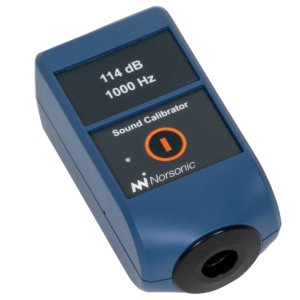 Nor1255 is a small battery-operated precision class 1 microphone calibrator generating 114 dB @ 1k Hz conforming to IEC 60942 and ANSI S1.40.
Nor1255 is a small battery-operated precision class 1 microphone calibrator generating 114 dB @ 1k Hz conforming to IEC 60942 and ANSI S1.40.
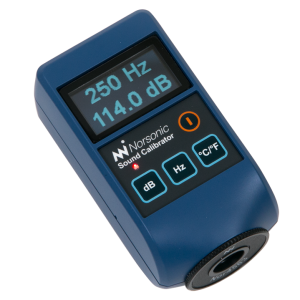 Nor1256 is a small battery-operated precision class 1 microphone calibrator conforming to IEC 60942 and ANSI S1.40.
Nor1256 is a small battery-operated precision class 1 microphone calibrator conforming to IEC 60942 and ANSI S1.40.
The combination of two different levels and two different frequencies allow both level linearity and frequency linearity to be verified. In addition the sound calibrator measures the environmental conditions; air pressure, temperature and humidity.

Mains Adaptor, 90-230 Vac input with standard EU mains plug, 12 Vdc output/EU
Mains Adaptor, 90-230 Vac input with UK mains plug, 12 Vdc output /UK
Mains Adaptor, 90-230 Vac input with US mains plug, 12 Vdc output /US
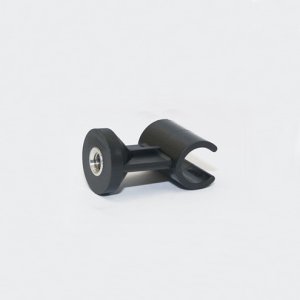
Nor1261 is a “clip-on” tripod adaptor for use with 1/2″ Preamplifiers. Tripod attachment threads is 1/4″.
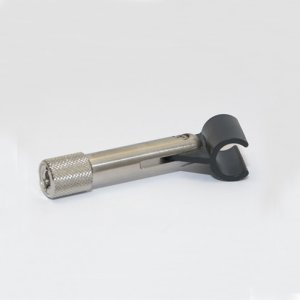
“Clip-on” adjustable Tripod Adaptor for 1/2″ Preamplifiers. Both 3/8″ and 1/4″ tripod screws can be used.
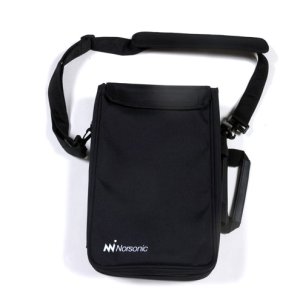
Softbag in nylon with room for sound level meter Nor140, calibrator, and accessories. The bag is normally included in Nor140 deliveries.

Cable (2m) for connection of Nor139 to a PC with 9-pin connector.
The Interface cable Nor1441 exists in two versions. Nor1441 and Nor1441B.
The Nor1441 is now obsolete and is replaced by the Nor1441B. The difference between the two is the connection of the handshake. The Nor1441B uses RTS/CTS handshake. The former version, Nor1441, uses DTR/DSR.
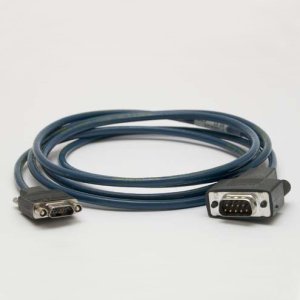
Cable (2m) for connecting a GSM-Modem with 9-pin socket, such as Siemens TC35i to RS-232 interface on Nor139.
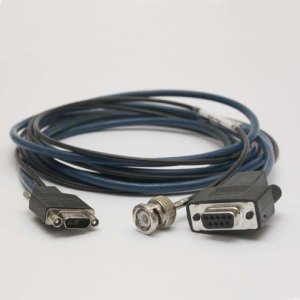
Nor4513B AC out and PC cable Cable, 2m, for simultaneous connection of Nor139to RS-232 interface and AC(Flat) output. The Interface cable Nor4513 exist in two versions. Nor4513A and Nor4513B. The Nor4513A is now obsolete and is replaced by the Nor4513B.
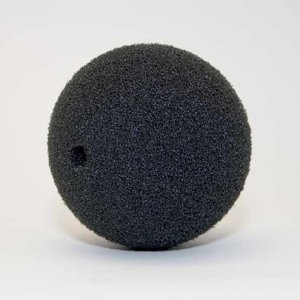
Wind Shield for 1/2″ microphones/preamplifiers. Diameter 90mm.

Wind Shield for 1/2″ microphones/preamplifiers. Diameter 60mm.
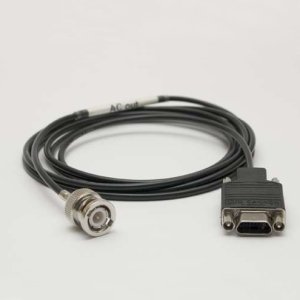
Cable (2m) for connecting the AC output of Nor140/Nor150 (Nor118) to external equipment such as power amplifiers etc.
Please note that the Nor4514 is replaced by Nor4514A. The A version is needed for use with the Nor140.
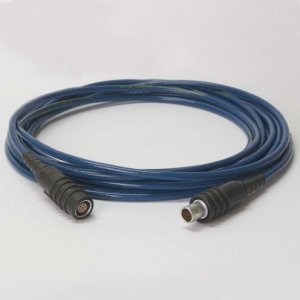
Preamplifier extension cable Nor1408A comes with Lemo connectors to fit directly in the measurement chain. The contact pins are gold plated and the connector housing is protected with a special rubber sleeve. This protects the connectors in use from moisture, dirt and bumps. The Nor1408A replaces the Nor1408. The A version is similar to the 1408 but has in addition added threads on the outer shell of the female connector to fix the lock ring on a Nor1206 and Nor1209 preamplifier. The cable is a general purpose cable suited for all preamplifiers following the Lemo 1B standard developed by Norsonic, such as Nor1201, Nor1203, Nor1204, Nor1206 and Nor1209 as well as preamplifiers of other brands.
Standard lengths are 5, 10, 20, 30 and 50 meters. Special lengths on request. The /xx in the order code denotes the length of the cable.
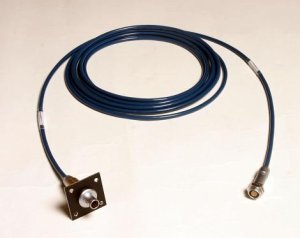
This cable is designed for fixed installations in test chambers. It has the same pinout as a standard Nor1408 cable.
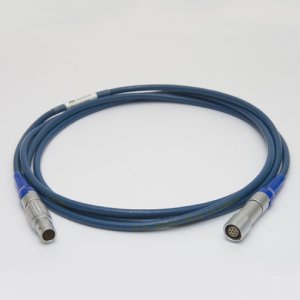
Preamplifier cable Nor1410A comes with Lemo connectors to fit directly in the measurement chain. It features high quality connectors with gold plated contact pins. The Nor1410A replaces the Nor1410. The A version is similar to the 1410 but has in addition added threads on the outer shell of the female connector to fix the lock ring on a Nor1206 or Nor1209 preamplifier. The cable is a general purpose cable suited for all preamplifiers following the Lemo 1B standard developed by Norsonic, such as Nor1201, Nor1203, Nor1204, Nor1206 and Nor1209 as well as preamplifiers of other brands.
Standard length is 2 meter. For special length see Nor1408A.
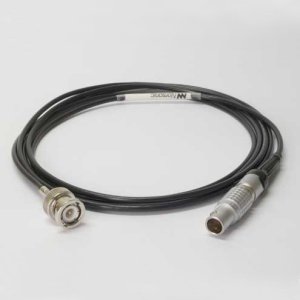
Nor1438 is a BNC to Lemo cable.
Having a length of 2 meters, this cable is a 3 mm thin and flexible cable with BNC connector in one end and a Lemo male in the other end. For connection of an electrical signal to a measuring instrument using Norsonic Lemo system.
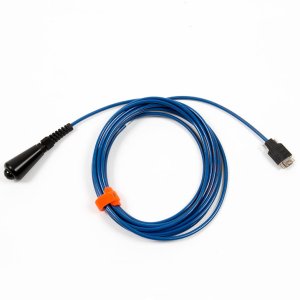
Remote hand switch with 5m cable for external triggering of start or audio recording (if applicable) on Nor145.
Norsonic’s Renowned Class I Sound Level Meter
The Nor140 is an advanced Class I sound level meter and analyzer with octave and 1/3 octave band analysis, and parallel A, C and Z weighting networks.